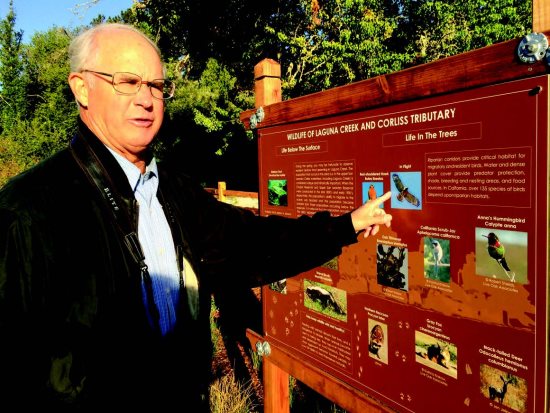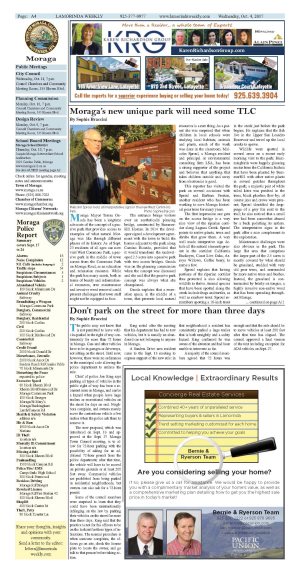| | Published October 4th, 2017
| Moraga's new unique park will need some TLC
| | | By Sophie Braccini |  | | Malcolm Sproul looks at interpretative signs in the new West Commons Park. Photo Sophie Braccini |
Moraga Mayor Teresa Onoda has been a longtime advocate of the concept of a passive park that provides access to examples of what natural Moraga was like through different phases of its history. As of Sept. 23 residents of all ages can now visit West Commons Park, a passive park in the middle of town across from the Commons Park on Moraga Road, as an education and relaxation resource. While the park has many assets, both in terms of beauty and informational resources, tree maintenance and invasive weed removal could present challenges that town staff might not be equipped to face.
 The entrance brings visitors over an aesthetically pleasing bridge, constructed by SummerHill Homes. In 2014 the developer signed a development agreement with the town to build the homes adjacent to the park along Camino Ricardo, provided that it would transform the undeveloped 2.5 acres into a passive park with two access bridges. Onoda was on the planning commission when the concept was discussed and she said that the passive park concept was always what she championed.
The entrance brings visitors over an aesthetically pleasing bridge, constructed by SummerHill Homes. In 2014 the developer signed a development agreement with the town to build the homes adjacent to the park along Camino Ricardo, provided that it would transform the undeveloped 2.5 acres into a passive park with two access bridges. Onoda was on the planning commission when the concept was discussed and she said that the passive park concept was always what she championed.
 Onoda explains that a recreation space, in the middle of a town, that presents local natural resources is a rare thing. As a parent she was surprised that when children in local schools were studying local habitats, animals and plants, much of the work was done in the classroom. Malcolm Sproul, a Moraga resident and principal at environmental consulting firm LSA, has been a strong supporter of the project and believes that anything that takes children outside and away from electronics is good.
Onoda explains that a recreation space, in the middle of a town, that presents local natural resources is a rare thing. As a parent she was surprised that when children in local schools were studying local habitats, animals and plants, much of the work was done in the classroom. Malcolm Sproul, a Moraga resident and principal at environmental consulting firm LSA, has been a strong supporter of the project and believes that anything that takes children outside and away from electronics is good.
 This reporter has visited the park on several occasions with Sproul and Barbara Preston, another resident who has been working to save Moraga historical pear trees for many years.
This reporter has visited the park on several occasions with Sproul and Barbara Preston, another resident who has been working to save Moraga historical pear trees for many years.
 The first impression one gets on the access bridge is a very nice view of the riparian corridor along Laguna Creek. Sproul points to native plants, trees and shrubs that grow there. A very well made interpretive sign details all the natural elements present in the corridor: California Buckeyes, Coast Live Oaks, Arroyo Willows, Coffee berry, to name a few.
The first impression one gets on the access bridge is a very nice view of the riparian corridor along Laguna Creek. Sproul points to native plants, trees and shrubs that grow there. A very well made interpretive sign details all the natural elements present in the corridor: California Buckeyes, Coast Live Oaks, Arroyo Willows, Coffee berry, to name a few.
 Sproul explains that having portions of the riparian corridor thus protected is also allowing wildlife to thrive. Animal species that have been spotted along the creek include frogs and turtles, as well as rainbow trout. Sproul remembers spotting a 16-inch trout in the creek just before the park begins. He explains that the fish live in the Upper San Leandro Reservoir and travel up the local creeks to spawn.
Sproul explains that having portions of the riparian corridor thus protected is also allowing wildlife to thrive. Animal species that have been spotted along the creek include frogs and turtles, as well as rainbow trout. Sproul remembers spotting a 16-inch trout in the creek just before the park begins. He explains that the fish live in the Upper San Leandro Reservoir and travel up the local creeks to spawn.
 Wildlife were spotted in several areas on a recent early morning visit to the park: Hummingbirds were happily gleaning nectar from the California fuchsia that have been planted by SummerHill with other native plants in several patches throughout the park; a majestic pair of white tailed kites was perched in the trees, black phoebes flew by; of course jays and crows were present; Sproul identified the droppings of a grey fox next to the trail; he also noticed that a small tree had been somewhat abused by a buck polishing its antlers. The interpretative signs in the park offer a nice complement to the exploration.
Wildlife were spotted in several areas on a recent early morning visit to the park: Hummingbirds were happily gleaning nectar from the California fuchsia that have been planted by SummerHill with other native plants in several patches throughout the park; a majestic pair of white tailed kites was perched in the trees, black phoebes flew by; of course jays and crows were present; Sproul identified the droppings of a grey fox next to the trail; he also noticed that a small tree had been somewhat abused by a buck polishing its antlers. The interpretative signs in the park offer a nice complement to the exploration.
 Maintenance challenges were also obvious in the park. The large flat area that comprises the larger part of the 2.5 acres is mostly covered by what should be grassland, studded with very old pear trees, and surrounded by more native trees and bushes. Instead, the grassland is contaminated by bristly ox tongue, a highly invasive non-native weed that has been spreading throughout Moraga.
Maintenance challenges were also obvious in the park. The large flat area that comprises the larger part of the 2.5 acres is mostly covered by what should be grassland, studded with very old pear trees, and surrounded by more native trees and bushes. Instead, the grassland is contaminated by bristly ox tongue, a highly invasive non-native weed that has been spreading throughout Moraga.
 When Preston visited the site she said that these weeds were ready to go to seed now, and that they should be pulled and taken away. Sproul commented that turning the dirt over as the maintenance staff often does at the Moraga Commons Park would entrench the seeds even deeper, and that instead it should be mowed twice a year to ensure native grasses ever grow there again.
When Preston visited the site she said that these weeds were ready to go to seed now, and that they should be pulled and taken away. Sproul commented that turning the dirt over as the maintenance staff often does at the Moraga Commons Park would entrench the seeds even deeper, and that instead it should be mowed twice a year to ensure native grasses ever grow there again.
 Some of the trees were also at issue, such as alders Sproul noted were planted in the middle of the park, which he says is the wrong placement for them, since these native trees grow in riparian corridors and need water. He recommended replacing them with valley oaks that already do very well there. And while the pear trees in the park showcase Moraga's agricultural past, the very old trees are not in great shape. Preston noted that many are overgrown, overtaken with fire blight or poison oak - a native plant. She says that it would probably take a group of 12 dedicated volunteers working in teams to prune and salvage the trees.
Some of the trees were also at issue, such as alders Sproul noted were planted in the middle of the park, which he says is the wrong placement for them, since these native trees grow in riparian corridors and need water. He recommended replacing them with valley oaks that already do very well there. And while the pear trees in the park showcase Moraga's agricultural past, the very old trees are not in great shape. Preston noted that many are overgrown, overtaken with fire blight or poison oak - a native plant. She says that it would probably take a group of 12 dedicated volunteers working in teams to prune and salvage the trees.
 The Moraga park maintenance staff did not return calls in time for this article. It is unlikely that the town would have the resources to maintain the park at the level required, since the budget for park maintenance was pared down during the recent budget cycle.
The Moraga park maintenance staff did not return calls in time for this article. It is unlikely that the town would have the resources to maintain the park at the level required, since the budget for park maintenance was pared down during the recent budget cycle.
 Preston said she hoped that a local service or Scout group would decide to take on maintaining the park as a community service project.
Preston said she hoped that a local service or Scout group would decide to take on maintaining the park as a community service project.


|
| | | | | | | | | | | | |



